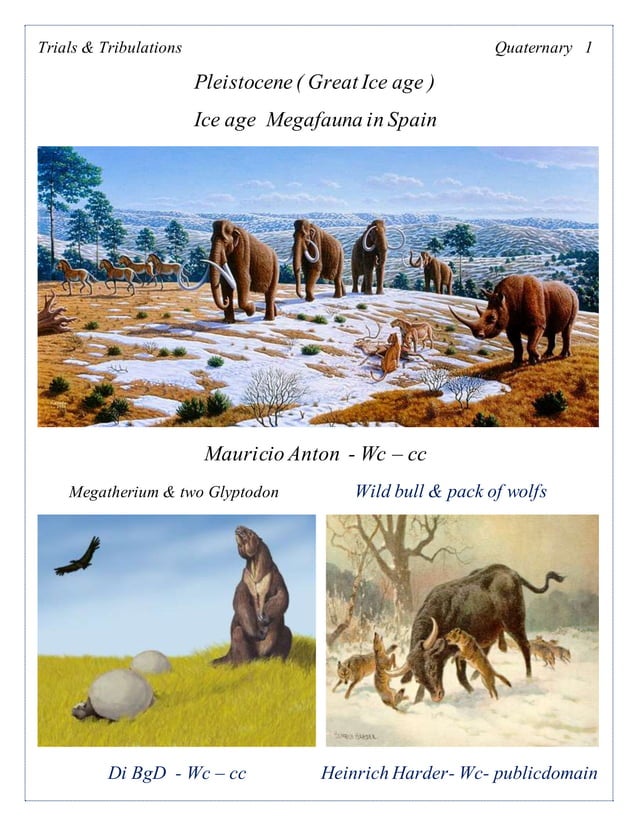21+ Pleistocene Mammals Of North America Pdf
The subfamily Ursinae originated approximately 42 million years ago. ə s iː n ˈ p l aɪ.

Pdf Starchy Foodways Surveying Indigenous Peoples Culinary Practices Prior To The Advent Of European Invasions In The Greater Caribbean Andy J Ciofalo Academia Edu
Old-timers African immigrants and recent North American immigrants.

. The fossilized teeth of Homo sapiens. It became extinct in Africa some 15. The wild boar Sus scrofa also known as the wild swine common wild pig Eurasian wild pig or simply wild pig is a suid native to much of Eurasia and North Africa and has been introduced to the Americas and OceaniaThe species is now one of the widest-ranging mammals in the world as well as the most widespread suiform.
It is used primarily by Earth scientists including geologists. Pierre and Miquelon Canada Greenland Bermuda Mexico Central America and the Caribbean region whether resident or as migrantsThis article does not include species found only in captivity. The aurochs Bos primigenius ˈ ɔː r ɒ k s or ˈ aʊ r ɒ k s is an extinct cattle species considered to be the wild ancestor of modern domestic cattle.
Mammal species which became extinct in the last 10000 to 13000 years are. The common pheasant Phasianus colchicus is a bird in the pheasant family PhasianidaeThe genus name comes from Latin phasianus pheasantThe species name colchicus is Latin for of Colchis modern day Georgia a country on the Black Sea where pheasants became known to Europeans. The American black bear Ursus americanus also called simply a black bear or sometimes a baribal is a medium-sized bear endemic to North AmericaIt is the continents smallest and most widely distributed bear species.
The megalonychid ground sloths first appeared in the Late Eocene about 35 million years ago in PatagoniaMegalonychids first reached North America by island-hopping prior to the formation of the Isthmus of PanamaSome lineages of megalonychids increased in. This is a list of the native wild mammal species recorded in South AmericaSouth Americas terrestrial mammals fall into three distinct groups. State and the 3rd largest by area.
There have been five or six major ice ages in the history of Earth over the past 3 billion years. The bear family Ursidae is thought to have split from other carnivorans about 38 million years ago. California is a state in the Western United States located along the Pacific CoastWith nearly 392 million residents across a total area of approximately 163696 square miles 423970 km 2 it is the most populous US.
The latest Lifestyle Daily Life news tips opinion and advice from The Sydney Morning Herald covering life and relationships beauty fashion health wellbeing. Paleontologists assign more than 80 genera of ground sloths to multiple families. The dire wolf Aenocyon dirus iː ˈ n ɒ s aɪ.
Prior to the 2009 revision of the. It is the second and most recent epoch of the Neogene Period in the Cenozoic EraThe Pliocene follows the Miocene Epoch and is followed by the Pleistocene Epoch. Also Pleiocene is the epoch in the geologic time scale that extends from 5333 million to 258 million years ago.
The Pliocene ˈ p l aɪ. The oldest known polar bear fossil is a 130000 to 110000-year-old jaw bone found on Prince Charles Foreland in 2004. Pleystotsenovyy park is a nature reserve on the Kolyma River south of Chersky in the Sakha Republic Russia in northeastern Siberia where an attempt is being made to re-create the northern subarctic steppe grassland ecosystem that flourished in the area during the last glacial period.
The geologic time scale or geological time scale GTS is a representation of time based on the rock record of EarthIt is a system of chronological dating that uses chronostratigraphy the process of relating strata to time and geochronology scientific branch of geology that aims to determine the age of rocks. The Great American Biotic Interchange commonly abbreviated as GABI also known as the Great American Interchange and the Great American Faunal Interchange was an important late Cenozoic paleozoogeographic biotic interchange event in which land and freshwater fauna migrated from North America via Central America to South America and vice versa as the. The species was named in 1858 four.
The Late Cenozoic Ice Age began 34 million years ago its latest phase being the Quaternary glaciation in progress since 258 million years ago. The Quaternary period from 2588 0005 million years ago to the present has seen the extinctions of numerous predominantly megafaunal species which have resulted in a collapse in faunal density and diversity and the extinction of key ecological strata across the globe. The Younger Dryas impact hypothesis YDIH or Clovis comet hypothesis is a speculative attempt to explain the onset of the Younger Dryas YD as an alternative to the long standing and widely accepted cause due to a significant reduction or shutdown of the North Atlantic Conveyor in response to a sudden influx of fresh water from Lake Agassiz and deglaciation in North.
The marsupials and xenarthrans are old-timers their ancestors having been present on the continent since at least the very early Cenozoic Era. The most prominent event in the Late Pleistocene is differentiated from previous Quaternary pulse. Fossils show that between 10000 and 20000 years ago the polar bears molar teeth.
American black bears are omnivores with their diets varying greatly depending on season and locationThey typically live in largely forested areas but will. These populations expanded south of the. ɒ n ˈ d aɪ r ə s is an extinct canineIt is one of the most famous prehistoric carnivores in North America along with its extinct competitor SmilodonThe dire wolf lived in the Americas and eastern Asia during the Late Pleistocene and Early Holocene epochs 1250009500 years ago.
This is a list of North American mammalsIt includes all mammals currently found in the United States St. They have a circumpolar distribution and are native to the Arctic sub-Arctic tundra boreal. Within ice ages there exist periods of more severe glacial conditions and more temperate conditions referred to as glacial periods and.
Although Phasianus was previously thought to be closely related to the genus. The green anaconda is the worlds heaviest and one of the worlds longest snakes reaching a length of up to 93 m 30 ft 6 in long. Paleo-Indians Paleoindians or Paleo-Americans were the first peoples who entered and subsequently inhabited the Americas during the final glacial episodes of the late Pleistocene period.
It has been assessed as least concern on the IUCN. It had massive elongated and broad horns that reached 80 cm 31 in in length. The prefix paleo- comes from the Greek adjective palaios παλαιός meaning old or ancient.
The hominid fossils of Peking Man a Homo erectus who used fire were discovered in a cave at Zhoukoudian near Beijing. Reindeer known as caribou in North America are deer in the genus RangiferFor the last few decades reindeer were assigned to one species Rangifer tarandus with about 10 subspeciesA 2022 revision of the genus elevated five of the subspecies to species see Taxonomy below. The settlement of the Americas began when Paleolithic hunter-gatherers entered North America from the North Asian Mammoth steppe via the Beringia land bridge which had formed between northeastern Siberia and western Alaska due to the lowering of sea level during the Last Glacial Maximum 26000 to 19000 years ago.
The legs are pink and the bill is black in winter and yellow in. More typical mature specimens reportedly can range up to 5 m 16 ft 5 in with adult females with a mean length of about 46 m 15 ft 1 in being generally much larger than the males which average around 3 m 9 ft 10 in. The common starling or European starling Sturnus vulgaris also known simply as the starling in Great Britain and Ireland is a medium-sized passerine bird in the starling family SturnidaeIt is about 20 cm 8 in long and has glossy black plumage with a metallic sheen which is speckled with white at some times of year.
The term Paleo-Indians applies specifically to the lithic period in the Western. It is also the most populated subnational entity in North America and the 34th most populous in the world. With a shoulder height of up to 180 cm 71 in in bulls and 155 cm 61 in in cows it was one of the largest herbivores in the Holocene.
China is regarded as one of the worlds oldest civilisations. They have been dated to between 680000 and 780000 years ago. Homotherium also known as the scimitar-toothed cat or scimitar cat is an extinct genus of machairodontine saber-toothed predator often termed scimitar-toothed cats that inhabited North America South America Eurasia and Africa during the Pliocene and Pleistocene epochs 4 mya 12000 years ago existing for approximately.
Archaeological evidence suggests that early hominids inhabited the country 225 million years ago.

Pleistocene Mammals Of North America Ppt Video Online Download

Wi All Late Pleistocene Megafauna Returns In 19th Century Spacebattles

Pdf Pleistocene Mammals In The Greater Yellowstone Ecosystem

Pdf Deciphering North American Pleistocene Extinctions

Pdf Deciphering North American Pleistocene Extinctions

Eastern North America During The Late Pleistocene R Naturewasmetal

Extinct Herbivorous Megafauna Of Mexico During The Late Pleistocene Period R Naturewasmetal

Pdf Range Sizes And Shifts Of North American Pleistocene Mammals Are Not Consistent With A Climatic Explanation For Extinction

Pdf Pleistocene Mammals In The Greater Yellowstone Ecosystem

Trials Tribulations Cchap 17 1 Pleistocene Epoch

Pdf Late Pleistocene Mammalian Extinctions In North America Taxonomy Chronology And Explanations

Pleistocene Of North America Illustration Stock Image C040 2692 Science Photo Library

Ecology Palaeontology And Taxonomy Of Echinocythereis Puri 1954 Crustacea Ostracoda With A Focus On The North Atlantic Species Brandao 2015 Papers In Palaeontology Wiley Online Library

Pleistocene Epoch North America

Pdf Range Sizes And Shifts Of North American Pleistocene Mammals Are Not Consistent With A Climatic Explanation For Extinction

Pleistocene Mammals Of North America Ppt Video Online Download

Pdf Northeastern North American Pleistocene Mammals Chronologically Overlapped Minimally With Paleoindians Matthew T Boulanger Academia Edu